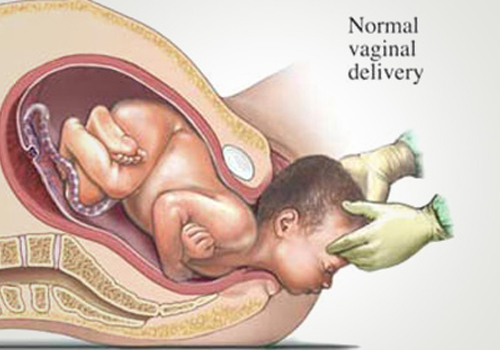
Normal Delivery refers to a vaginal childbirth where the baby is delivered through the birth canal without the need for major surgical intervention like a cesarean section. It is the most natural and common method of childbirth.
Stages of Normal Delivery
-
First Stage: Early and Active Labor
- Early Labor:
- Cervix begins to thin (efface) and open (dilate) up to 4 cm.
- Contractions are mild and irregular, gradually becoming stronger and more regular.
- Duration: A few hours to several days, especially for first-time mothers.
- Active Labor:
- Cervix dilates from 4 cm to 10 cm.
- Contractions become intense and frequent (3-5 minutes apart).
- Duration: 4-8 hours on average.
- Early Labor:
-
Second Stage: Pushing and Delivery
- Cervix is fully dilated (10 cm), and the baby moves down the birth canal.
- Mother actively pushes with each contraction.
- Baby's head appears (crowning), followed by the rest of the body.
- Duration: 20 minutes to 2 hours.
-
Third Stage: Delivery of the Placenta
- After the baby is born, the placenta (afterbirth) is delivered.
- Mild contractions help expel the placenta.
- Duration: 5-30 minutes.
Preparation for Normal Delivery
-
Antenatal Care:
- Regular check-ups to monitor maternal and fetal health.
- Maintaining a healthy diet and staying physically active.
-
Breathing and Relaxation Techniques:
- Practice breathing exercises (e.g., Lamaze technique) to manage labor pain.
- Learn relaxation methods to reduce stress during labor.
-
Pelvic Floor Exercises:
- Strengthen pelvic muscles through Kegel exercises.
- Improves control during childbirth.
-
Birth Plan:
- Discuss preferences with the healthcare provider (e.g., pain relief methods, birthing position).
-
Support System:
- Identify a trusted partner, doula, or family member for emotional and physical support during labor.
Signs of Labor
- Regular contractions that increase in intensity and frequency.
- Water breaking (rupture of the amniotic sac).
- Bloody show (release of the mucus plug from the cervix).
- Back pain or pelvic pressure.
Benefits of Normal Delivery
- Quick Recovery:
- Shorter hospital stay and faster return to normal activities compared to cesarean delivery.
- Lower Risk of Complications:
- Reduced risk of infection and surgical complications.
- Immediate Bonding:
- Skin-to-skin contact and breastfeeding are often initiated immediately.
- Enhanced Immunity for Baby:
- Passage through the birth canal exposes the baby to beneficial bacteria, boosting their immune system.
Pain Management During Normal Delivery
- Non-Medical Methods:
- Breathing techniques, warm showers, massages, or aromatherapy.
- Medical Methods:
- Epidural anesthesia, nitrous oxide, or localized pain relief injections.

